Politics
 Originally, in the United States, each branch of the service had their own day to celebrate their service, but on August 31, 1949, Defense Secretary Louis Johnson announced the creation of an Armed Forces Day to replace separate Army, Navy, Air Force, Marine Corps, and Coast Guard Days. There was a good reason for it. The combination coincided with the unification of the three branches of the service under one agency…the Department of Defense. Man countries have an Armed Forces Day, and they are all done a little differently. In the United States, Armed Forces Day is celebrated on the third Saturday in May, which is near the end of Armed Forces Week, which begins on the second Saturday of May and ends on the third Sunday of May, or the fourth Saturday if the month begins on a Sunday, such as in 2016. Following the creation of Armed Forces Day in 1949, the holiday was first observed on May 20, 1950.
Originally, in the United States, each branch of the service had their own day to celebrate their service, but on August 31, 1949, Defense Secretary Louis Johnson announced the creation of an Armed Forces Day to replace separate Army, Navy, Air Force, Marine Corps, and Coast Guard Days. There was a good reason for it. The combination coincided with the unification of the three branches of the service under one agency…the Department of Defense. Man countries have an Armed Forces Day, and they are all done a little differently. In the United States, Armed Forces Day is celebrated on the third Saturday in May, which is near the end of Armed Forces Week, which begins on the second Saturday of May and ends on the third Sunday of May, or the fourth Saturday if the month begins on a Sunday, such as in 2016. Following the creation of Armed Forces Day in 1949, the holiday was first observed on May 20, 1950.
In his speech proclaiming the day as Armed Forces Day, on February 27, 1950, President Truman stated, “Armed Forces Day, Saturday, May 20, 1950, marks the first combined demonstration by America’s defense  team of its progress, under the National Security Act, toward the goal of readiness for any eventuality. It is the first parade of preparedness by the unified forces of our land, sea, and air defense.” Of course, there is more to planning a holiday that a day and a speech. The first Armed Forces Day was celebrated by parades, open houses, receptions, and air shows. The longest continuously running Armed Forces Day Parade in the United States is held in Bremerton, Washington.
team of its progress, under the National Security Act, toward the goal of readiness for any eventuality. It is the first parade of preparedness by the unified forces of our land, sea, and air defense.” Of course, there is more to planning a holiday that a day and a speech. The first Armed Forces Day was celebrated by parades, open houses, receptions, and air shows. The longest continuously running Armed Forces Day Parade in the United States is held in Bremerton, Washington.
There were a few glitches, however. The unique training schedules of the National Guard and Reserve units make the specific Saturday celebration difficult for these branches, so they have adapted to celebrate Armed Forces Day/Week over any period in the month of May. Every nation needs to celebrate the military forces. Where would we be without a strong military. As President Truman said, “It is vital to the security of the nation and to the establishment of a desirable peace.”
Each year, Armed Forces Day theme is different, because of course, each year more and more has changed. The very first theme was “Teamed for Defense.” Over the years, other themes have included Appreciation of a Nation; Arsenal of Freedom and Democracy; Dedication and Devotion; Deter if Possible, Fight if Necessary;  Freedom; Freedom Through Unity; Guardians of Peace; Lasting Peace; Liberty; and Patriotism. In Washington DC, 10,000 troops of all branches of the military, cadets, and veterans marched past the president and his party. In New York City, an estimated 33,000 participants initiated Armed Forces Day “under an air cover of 250 military planes of all types.” Today, Armed Forces Day is celebrated in American communities and on military bases throughout the world with parades, picnics, shopping discounts, festivals, and parties. On May 19, 2017, President Donald Trump reaffirmed the Armed Forces Day holiday, marking the 70th anniversary since the creation of the Department of Defense.
Freedom; Freedom Through Unity; Guardians of Peace; Lasting Peace; Liberty; and Patriotism. In Washington DC, 10,000 troops of all branches of the military, cadets, and veterans marched past the president and his party. In New York City, an estimated 33,000 participants initiated Armed Forces Day “under an air cover of 250 military planes of all types.” Today, Armed Forces Day is celebrated in American communities and on military bases throughout the world with parades, picnics, shopping discounts, festivals, and parties. On May 19, 2017, President Donald Trump reaffirmed the Armed Forces Day holiday, marking the 70th anniversary since the creation of the Department of Defense.

 April 19, 1995 was a normal spring morning in Oklahoma City, Oklahoma, but by 9:02am, all that would change forever. This was the day that antigovernment extremists, Timothy McVeigh and Terry Nichols had chosen to tell the world that they didn’t like things going the way they were. The biggest problem was not that they wanted to protest, because that is their right, but it was the way they chose to protest that was completely criminal.
April 19, 1995 was a normal spring morning in Oklahoma City, Oklahoma, but by 9:02am, all that would change forever. This was the day that antigovernment extremists, Timothy McVeigh and Terry Nichols had chosen to tell the world that they didn’t like things going the way they were. The biggest problem was not that they wanted to protest, because that is their right, but it was the way they chose to protest that was completely criminal.
That morning, McVeigh parked a Ryder truck in front of the Alfred P Murrah Federal Building and then, he walked away. No warning was issued, because nothing was considered to be out of place, but that day about a thousand people started their day in the building, only to have their lives forever changed, or ended. The bomb went off at 9:02am, and in that moment, more than one-third of the building was destroyed, 168 people lost their lives, and about 800 were injured. The dead included 19 children in the on-site daycare facility. The blast destroyed or damaged 324 other buildings within a 16-block radius, shattered glass in 258 nearby buildings, and destroyed or burned 86 cars, causing an estimated $652 million worth of damage. In response to the attack, local, state, federal, and worldwide agencies quickly mobilized in extensive rescue. The Federal Emergency Management Agency (FEMA) activated 11 of its Urban Search and Rescue Task Forces, consisting of 665 rescue workers who assisted in rescue and recovery operations.
The investigation moved rapidly, and within 90 minutes of the explosion, McVeigh was stopped by Oklahoma Highway Patrolman Charlie Hanger for driving without a license plate and arrested for illegal weapons possession. It seems that most criminals make mistakes that lead to their downfall. Forensic evidence quickly 
 linked McVeigh and Nichols to the attacks. Nichols was arrested and within days, both were charged. Michael and Lori Fortier were later identified as co-conspirators. McVeigh, a veteran of the Gulf War and a sympathizer with the US militia movement, had detonated the Ryder rental truck filled with explosives and Nichols had assisted with the bomb’s preparation. Motivated by his dislike for the US federal government and unhappy about its handling of the Ruby Ridge incident in 1992 and the Waco siege in 1993, McVeigh timed his attack to coincide with the second anniversary of the fire that ended the siege at the Branch Davidian compound in Waco, Texas.
linked McVeigh and Nichols to the attacks. Nichols was arrested and within days, both were charged. Michael and Lori Fortier were later identified as co-conspirators. McVeigh, a veteran of the Gulf War and a sympathizer with the US militia movement, had detonated the Ryder rental truck filled with explosives and Nichols had assisted with the bomb’s preparation. Motivated by his dislike for the US federal government and unhappy about its handling of the Ruby Ridge incident in 1992 and the Waco siege in 1993, McVeigh timed his attack to coincide with the second anniversary of the fire that ended the siege at the Branch Davidian compound in Waco, Texas.
I could never understand why terrorists consider it necessary to take out so many innocent lives in order to make their grievances known. The official FBI investigation was known as “OKBOMB” involved 28,000 interviews, 3.5 short tons of evidence and nearly one billion pieces of information. The bombers were tried and convicted in 1997. McVeigh was sentenced to death, and was executed by lethal injection on June 11, 2001, at the US federal penitentiary in Terre Haute, Indiana. Nichols was sentenced to life in prison in 2004. Michael and Lori Fortier testified against McVeigh and Nichols, in exchange for a plea-deal. Michael Fortier was sentenced to 12 years in prison for failing to warn the United States government, and Lori received immunity from prosecution in exchange for her testimony. Michael was released into witness protection in 2006.
The US Congress passed the Antiterrorism and Effective Death Penalty Act of 1996, which tightened the standards for habeas corpus in the United States n response to the bombing. It also passed legislation to increase the protection around federal buildings to deter future terrorist attacks. Prior to the September 11th attacks in 2001, the Oklahoma City bombing was the deadliest terrorist attack in the history of the United 
 States, other than the Tulsa race massacre. It remains one of the deadliest acts of domestic terrorism in US history. On April 19, 2000, the Oklahoma City National Memorial was dedicated on the site of the Murrah Federal Building, commemorating the victims of the bombing. Remembrance services are held every year on April 19, at the time of the explosion.
States, other than the Tulsa race massacre. It remains one of the deadliest acts of domestic terrorism in US history. On April 19, 2000, the Oklahoma City National Memorial was dedicated on the site of the Murrah Federal Building, commemorating the victims of the bombing. Remembrance services are held every year on April 19, at the time of the explosion.
 When thinking of spies, our minds might logically think of James Bond 007 or some of the NCIS shows, but we somehow don’t think of women…at least not very often. Nevertheless, the truth is there are many women who are spies, and some of them were in the era of World War II. These women were gutsy. They faced danger defiantly. Jannetie “Hannie” Schaft was a Dutch resistance fighter during World War II. She could have done like so many others, and obediently taken the oath of loyalty to the Nazis. Her life would have gone on somewhat like it had before.
When thinking of spies, our minds might logically think of James Bond 007 or some of the NCIS shows, but we somehow don’t think of women…at least not very often. Nevertheless, the truth is there are many women who are spies, and some of them were in the era of World War II. These women were gutsy. They faced danger defiantly. Jannetie “Hannie” Schaft was a Dutch resistance fighter during World War II. She could have done like so many others, and obediently taken the oath of loyalty to the Nazis. Her life would have gone on somewhat like it had before.
Schaft was born in Haarlem, which is the capital of the province of North Holland. Her mother was Aafje Talea Schaft (née Vrijer), who was a Mennonite woman. Her father, Pieter Schaft was attached to the Social Democratic Workers’ Party. Schaft led a sheltered life, because her parents were very protective of her following the death of her older sister. Her sheltered upbringing did not affect her personality. She was as  bold and defiant as ever. When the Nazis wanted the people to swear allegiance to them, Schaff refused to do so. Instead, she joined Raad van Verzet, a resistance group with a communist ideology. I find it hard to think about communism being considered better than socialism, but many have considered it so. In her work for Raad van Verzet, Schaft spied on soldier activity, aided refuges, and sabotaged targets. She was very capable, and feared by many. Her work gained her the reputation as “the girl with the red hair.” While it was only a nickname, it would end up being her downfall.
bold and defiant as ever. When the Nazis wanted the people to swear allegiance to them, Schaff refused to do so. Instead, she joined Raad van Verzet, a resistance group with a communist ideology. I find it hard to think about communism being considered better than socialism, but many have considered it so. In her work for Raad van Verzet, Schaft spied on soldier activity, aided refuges, and sabotaged targets. She was very capable, and feared by many. Her work gained her the reputation as “the girl with the red hair.” While it was only a nickname, it would end up being her downfall.

Having a reputation based on the color of your hair could be a good thing. All you have to do is color your hair, and you have the perfect disguise…right? Well, it did work for a time. Schaft colored her hair to cover up the red, but then she was captured by the Nazis. They had no idea who they had, but as her hair began to grow out they quickly figured it out. Once the Germans discovered that they had the legendary spy and resistance fighter in captivity, I’m sure she was brutally beaten and tortured for information. Schaft was then executed on April 17, 1945. Schaft was never a quitter and she wouldn’t quit now. Defiant to the end, she began taunting the soldier who shot her in the head, but merely grazed her. She said, “I can shoot better than that.” The second shot killed her, but not before leaving an everlasting impression on her captors and witnesses. Schaft was just 24 years old when she died. She was given a state funeral after the war, attended by Queen Wilhelmina and the Dutch royal family.

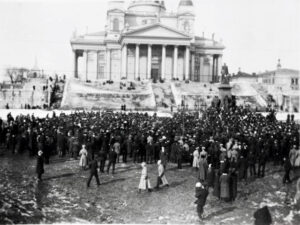 There are different kinds of governments, some good and some bad. The problem these days is that people are confused about which one is the best. On April 13, 1918, the people of Helsinki, Finland were not among the confused. They had lived under a capitalist government, and they had lived under a socialist government, and there was no doubt in their minds that they did not want to live in socialism any longer.
There are different kinds of governments, some good and some bad. The problem these days is that people are confused about which one is the best. On April 13, 1918, the people of Helsinki, Finland were not among the confused. They had lived under a capitalist government, and they had lived under a socialist government, and there was no doubt in their minds that they did not want to live in socialism any longer.
Finland had been under Russian rule since 1809. With the upheaval in Russia in 1917, which included the abdication of Czar Nicholas II in March and the rise to power of Vladimir Lenin and his radical socialist followers, the Bolsheviks, in November, Finland decided to declare its independence in December, 1917. Unfortunately, conflict broke out almost immediately between radical socialists, who were supporters of the Bolsheviks in Russia, and the anti-socialists within the government. In late January 1918, the radical socialist Red Guard launched a rebellion, terrorizing and killing civilians in their attempt to spark a Bolshevik-style revolution. It reminds me of the riots because of the left’s push to socialism in this country. The Whites (as government troops were known) under the command of Baron Karl Gustav Mannerheim found themselves in a bitter struggle to drive the Red Guard (as the Bolsheviks and socialists were known) out of Finland.
On April 3, 1918, German troops who had been sent by Kaiser Wilhelm II, landed in Finland to aid Mannerheim’s White army. Germany had made an agreement to support Finland and its newly declared parliamentary government. German troops, alongside Mannerheim and his force of 16,000 men, fought to take back control of Helsingfors (Helsinki) from the Red Guard, an army of Finnish supporters of the Russian Bolsheviks, on April 13, 1918. That victory was followed by another in Viborg by the end of the month. Another major victory by the Germans and the White Finns took place at Lahti on May 7, 1918. It was that battle that ended the Finnish civil war.
Germany’s close ties with the emerging Finnish government reached a new level in October 1918. Conservative forces in Finland decided to establish monarchal rule in the country, giving the throne to Frederick, a German prince, in the remaining weeks of World War I. However, Kaiser Wilhelm himself had abdicated by the time the Central Powers appealed for an armistice one month later and it seemed certain that the victorious Allies would not look kindly upon a German prince on the Finnish throne, so Frederick abdicated on December 14. The Treaty of Versailles, signed in June 1919, recognized Finland’s hard-won independence. That July, the Finnish parliament adopted a new republican constitution, and liberal Kaarlo J Stahlberg, was elected as the country’s first president.
Today, Finland is considered a republic with representative democracy. The public administration is composed of the highest elected bodies, state administration, local government, and the courts. The highest elected body is 
 made up of the parliament, the president, and the government. The current president of Finland is Sauli Niinistö, who has been president since March 1, 2012. The Parliament of Finland exercises the legislative powers while the executive power is exercised by the cabinet supervised by the premier who heads the government of Finland. The president heads the state and has powers to make a decision concerning some matters such as personal appointments and pardons.
made up of the parliament, the president, and the government. The current president of Finland is Sauli Niinistö, who has been president since March 1, 2012. The Parliament of Finland exercises the legislative powers while the executive power is exercised by the cabinet supervised by the premier who heads the government of Finland. The president heads the state and has powers to make a decision concerning some matters such as personal appointments and pardons.
 Pirates, as we know them, are criminals who hijack ships to rob them of anything of value on board. Sometimes however, a “pirate” can actually be working for the government, or at least on behalf of the government. Such was the case on April 10, 1778, when Commander John Paul Jones and his crew of 140 men aboard the USS Ranger set sail from the naval port at Brest, France. They headed toward the Irish Sea. Their mission was to begin raids on British warships. This was the first mission of its kind during the Revolutionary War. These missions weren’t called piracy, but when we compare the two acts, they pretty much were piracy. They just weren’t for personal gain, but rather for the good of the country and the war effort. No one was safe, not passengers and certainly not the crew.
Pirates, as we know them, are criminals who hijack ships to rob them of anything of value on board. Sometimes however, a “pirate” can actually be working for the government, or at least on behalf of the government. Such was the case on April 10, 1778, when Commander John Paul Jones and his crew of 140 men aboard the USS Ranger set sail from the naval port at Brest, France. They headed toward the Irish Sea. Their mission was to begin raids on British warships. This was the first mission of its kind during the Revolutionary War. These missions weren’t called piracy, but when we compare the two acts, they pretty much were piracy. They just weren’t for personal gain, but rather for the good of the country and the war effort. No one was safe, not passengers and certainly not the crew.
Commander John Paul Jones, will always be remembered as one of the most daring and successful naval commanders of the American Revolution. John Paul Jones was born under the simple birth name of John Paul on July 6, 1747, in a small cottage in Arbigland, Scotland, to John Paul Sr and Margaret Paul. His dad was a gardener, but Jones found his calling not in gardening, but at sea. He earned an apprenticeship with the British Merchant Marine at the age of 13. His seafaring adventures would eventually take him to America and, like many other sailors before him, Jones got involved in the slave trade. However, the realities of human trafficking repulsed him, and he returned to shipping cargo duties.
1773 found Jones in a very difficult situation. He murdered a mutinous sailor on the island of Tobago in self-defense…which is not really murder, but maybe in those days things were different. Whatever the case may be,  Jones believed he wouldn’t receive a fair trial, so he fled to America. It was there he added the last name “Jones” to conceal his identity. Jones needn’t have worried, because the American colonies were too busy stoking the flames of war with the British to have noticed his past. When the American Revolution broke out in 1775, Jones who remembered Britain’s cruel treatment of the Scots, decided that he would side with the colonists. He joined the new Continental Navy.
Jones believed he wouldn’t receive a fair trial, so he fled to America. It was there he added the last name “Jones” to conceal his identity. Jones needn’t have worried, because the American colonies were too busy stoking the flames of war with the British to have noticed his past. When the American Revolution broke out in 1775, Jones who remembered Britain’s cruel treatment of the Scots, decided that he would side with the colonists. He joined the new Continental Navy.
Jones began skillfully attacking British ships off the American coastline and expanded his operations from there. He first captained the USS Providence, set sail to Nova Scotia, and started capturing British vessels. Next, he took command of Ranger and set course to France, where his vessel was saluted by the French Admiral La Motte Piquet. It was the first American vessel ever to be recognized by a foreign power…pretty good for a new country. In 1779 Jones made history as one of the greatest naval commanders of the Revolutionary War. His shining moment came when, while En route to raid British shipping, Jones’ warship, Bon Homme Richard, came head to head with the more powerful English warship HMS Serapis off the North Sea. The battle went on for three hours between the two vessels. At one point, Jones slammed Bon Homme into Serapis, strategically tying them together. As the story goes, when the British asked if Jones was ready to surrender, he famously responded, “I have not yet begun to fight!” Inspired by Jones’ bravado, one of his naval officers tossed a grenade onto Serapis. The severe damage caused the British to surrender in the end. Jones’ became an  international hero. After the war ended, the Continental Navy dissolved due to lack of funds. Jones was dubbed the father of the United States Navy.
international hero. After the war ended, the Continental Navy dissolved due to lack of funds. Jones was dubbed the father of the United States Navy.
Jones retired to Paris, but his health took a turn for the worse. On July 18, 1792, he was found dead in his apartment at the age of 45. He was laid to rest in a French cemetery, but the plot of land was later sold and forgotten. Over one hundred years would pass before the United States was able to recover Jones’ remains with the help of French officials. After much research, his body was located and exhumed, and to the surprise of French pathologists, Jones’ body was excellently preserved. His initial autopsy concluded that the cause of his death was kidney failure, with later clinical studies believing his condition was exacerbated by a heart arrhythmia. The United States received Jones’ remains and buried them in a tomb inside the chapel of the U.S. Naval Academy in Annapolis, Maryland.

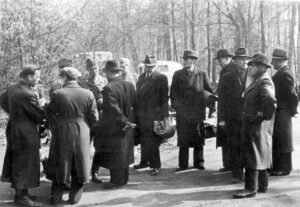 Being arrested is probably one of the scariest things that can happen to a person, especially when they have done nothing wrong. For most of us, that will never happen, but it could, if our government is corrupt and run by a dictator. Such was the case in Nazi Germany. After Hitler was elected, he began to dismantle the police department, filling it with men who were loyal to him. Then, he gave them unlimited authority to go after anyone who disagreed with his plan. These people were not guilty of any crime, they were simply on the wrong side of the political and spiritual agenda of the time.
Being arrested is probably one of the scariest things that can happen to a person, especially when they have done nothing wrong. For most of us, that will never happen, but it could, if our government is corrupt and run by a dictator. Such was the case in Nazi Germany. After Hitler was elected, he began to dismantle the police department, filling it with men who were loyal to him. Then, he gave them unlimited authority to go after anyone who disagreed with his plan. These people were not guilty of any crime, they were simply on the wrong side of the political and spiritual agenda of the time.
The Nazis set out to control every aspect of the lives of the people now under their control…making them little more than servants. It was a very dehumanizing system, whether the people were Jewish, Christian, Agnostic, or Atheist. Even the people who were in Hitler’s “good graces,” knew that one false move would end life as they knew it, or even get them killed. The Third Reich was the final authority in all things…at least at the time. The people were even subject to Hitler’s rules in the privacy of their own homes. The neighbors, and even some of their family members, became spies for the Third Reich. Once a “violation” was reported by anyone, the “perpetrator” was arrested, commonly in the middle of the night, hauled away, and often, never seen again. The Nazi leadership dramatically redefined the role of the police, giving them broad powers, completely independent of judicial review, to search, arrest, and incarcerate real or perceived state enemies and others they considered criminals.
Once a person was arrested, the police could do anything they chose to them to get them to talk…confess to their crimes. The victims of the police taken to Gestapo Headquarters where they were raped, beaten, tortured, enslaved, starved, and often killed, with no repercussions against the police at all. Their actions were considered above the law. They could even do those things to the people on the street, who were not under arrest for anything. The Supreme Court of that day, failed to challenge or protest the loss of judicial authority at this time. In general, it approved of the Nazi leadership’s decisive action. Further, the Supreme Court had been the court of first instance for treason cases since the Imperial period but, by the 1930s, it was overburdened with such trials and had endured relentless criticism from all sides for the judgments it rendered. The court was ultimately relieved to have responsibility for political crimes removed from its jurisdiction. It was another way to remove power from it’s proper place, and put it in the hands of the police, and ultimately Hitler.
The Secret State Police, called the Gestapo, which investigated political opposition, and the Criminal Police, called the Kripo, which handled all other types of criminal activity, were the two civilian forms of law enforcement officers. In addition, Hitler had the SS or the SA, which also imposed public order, but were considered paramilitary forces. The Gestapo was often used “protective custody” (Schutzhaft) to incarcerate people indefinitely, without specific charge or trial. These people were deemed to be potentially dangerous to the security of the Reich. Protective custody had been introduced in the German general law code before World War I to detain individuals for their own protection or to avert an immediate security threat if there were no other recourse. Do not be fooled by this. It was anything, but protective. The Gestapo employed protective custody to arrest political opponents at first, but later Jews, as well as Jehovah’s Witnesses who, because of religious conviction, refused to swear an oath to the Nazi German state or to serve in the armed forces. So, now the people could not speak out politically or religiously, and remember that their gun were also gone. It was a precarious place to be. Hitler was in charge, and he considered anyone who opposed him expendable.
So just imagine, you are asleep in your bed, after a nice Easter dinner with your family, and there comes a knock at the door…or rather a pounding at the door. The door bursts open and the police come in and drag your husband, wife, or even children away with barely a word spoken. No one was exempt. Kids could speak the 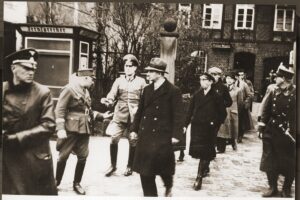
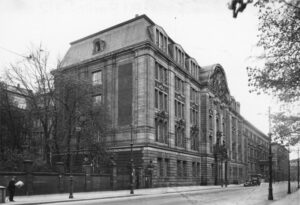 wrong things too. Of course, usually parents were the ones hauled away for what they taught the children. Children were taken into “protective custody” to be retrained in “proper” thinking…in other words, Nazism. Those were perilous times, and times that should never be forgotten. Failing to remember the horrors of the past, opens us up to a repetition of past mistakes in a future time.
wrong things too. Of course, usually parents were the ones hauled away for what they taught the children. Children were taken into “protective custody” to be retrained in “proper” thinking…in other words, Nazism. Those were perilous times, and times that should never be forgotten. Failing to remember the horrors of the past, opens us up to a repetition of past mistakes in a future time.
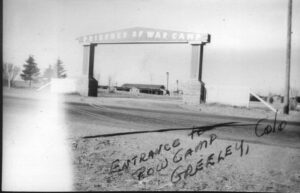 For some reason, when I think of Prisoner of War (POW) camps, I think of a place far away in a war zone, and there were some there, but as they filled up, the prisoners had to be moved to other areas. In addition to that, we needed men to work in the United States because our men were overseas fighting. The prisoners could be put to work in the fields to help grow needed foods for the country, as well as the troops. That idea was a bit foreign to me, especially when I heard that there was just such a camp that was practically in my backyard…even if I wasn’t born at the time. It’s just odd when history collides with your own neighborhood.
For some reason, when I think of Prisoner of War (POW) camps, I think of a place far away in a war zone, and there were some there, but as they filled up, the prisoners had to be moved to other areas. In addition to that, we needed men to work in the United States because our men were overseas fighting. The prisoners could be put to work in the fields to help grow needed foods for the country, as well as the troops. That idea was a bit foreign to me, especially when I heard that there was just such a camp that was practically in my backyard…even if I wasn’t born at the time. It’s just odd when history collides with your own neighborhood.
During World War II, the Greeley, Colorado POW camp had prisoners from Germany and Austria. The camp was built in 1943, and the first prisoners came in 1944. The camp was a self-contained town in itself. It had a fire station, hospital, theater, library, and classrooms. It also had electricity, water, and sewers. The prisoners who were held in the POW camps in the United States were treated well. This country wasn’t into the torture methods that the Axis of Evil nations were.

Many of the prisoners worked in the fields and paid money, for their labor, to take home with them. They were also given the chance to have fun. They had soccer teams. They dyed their t-shirts different colors using homemade dyes from vegetables. They had classes in English, German, and Mathematics. Some men were in the camp orchestra and others sang in choir. In many ways, the lives these men lived in the POW camps was better than the lives they lived at home…or at least during the war.
The Greeley POW Camp 202, was almost like a coveted assignment. It was the place the prisoners wanted to be sent. When new prisoners came to the camp, they would try to find men from their hometowns…hoping others had been as blessed as they felt to be there. The story is told that, “The old prisoners would toss out gum or paper with their names and address. One day a father and son found each other from the tossed notes.” These reunions were such a blessing for the prisoners. The guards were well liked. In fact, when one of the guards got married, the prisoners cooked their wedding night dinner for them. These good guards found favor with the prisoners.

I like to think that POW camps in and run by the United States were and are more civilized than those camps owned and run by other countries, but I don’t suppose all of them were run as compassionately as the Greeley POW Camp. We hear nightmare stories of Guantanamo Bay, and I’m sure there are others that weren’t so great. Still, I suppose things depend on the prisoners to a great degree. It is harder to show kindness to a prisoner who orchestrates a terrorist attack against our nation, killing thousands of innocent people, that it is to be compassionate to a soldier who is simply following orders, but is otherwise a kind and gentle person.
 Since man had power on the earth, man has also had power outages. Power outages are one thing, but rolling blackouts are another thing altogether. “A rolling blackout, also known as rotational load shedding, feeder rotation, or a rotating outage is an intentionally-engineered electrical power shutdown in which electricity delivery is stopped for non-overlapping periods of time over different parts of the distribution region.” This type of shutdown…rolling blackouts…are a supposed to be a last-resort measure used by an electric utility company to avoid a total blackout of the power system. I can understand that in a serious heat wave, even though it is a dangerous maneuver, and I can even understand it in an overload caused by an unexpected cold snap, even thought that is also seriously dangerous.
Since man had power on the earth, man has also had power outages. Power outages are one thing, but rolling blackouts are another thing altogether. “A rolling blackout, also known as rotational load shedding, feeder rotation, or a rotating outage is an intentionally-engineered electrical power shutdown in which electricity delivery is stopped for non-overlapping periods of time over different parts of the distribution region.” This type of shutdown…rolling blackouts…are a supposed to be a last-resort measure used by an electric utility company to avoid a total blackout of the power system. I can understand that in a serious heat wave, even though it is a dangerous maneuver, and I can even understand it in an overload caused by an unexpected cold snap, even thought that is also seriously dangerous.
I don’t know a lot about the energy industry, but I do know that some of the recent cuts in types of energy resources are very dangerous when it comes to making sure that we have enough energy for our country. It  seems that these states who don’t regularly need large amounts of energy for heating and cooling, don’t have a way to “stockpile” any either. Rolling blackouts are used as a response strategy to cope with reduced output beyond reserve capacity from power stations taken offline unexpectedly, such as an extreme weather event. So, when an emergency occurs, their solution is to have these rolling blackouts. California has done this for years.
seems that these states who don’t regularly need large amounts of energy for heating and cooling, don’t have a way to “stockpile” any either. Rolling blackouts are used as a response strategy to cope with reduced output beyond reserve capacity from power stations taken offline unexpectedly, such as an extreme weather event. So, when an emergency occurs, their solution is to have these rolling blackouts. California has done this for years.
The theory behind the rolling blackouts is a “measure of demand” response. If the demand for electricity exceeds the power supply capability of the network, it’s time to have a planned blackout. Rolling blackouts might be limited to a single city or state, or they can be district or nationwide. The whole thing depends on the network and the stockpile of energy resources. Rolling blackouts generally result from two causes. These are insufficient generation capacity or inadequate transmission infrastructure to deliver power to where it is needed.
For California the rolling blackouts had began on June 14th, 2000 due to a heatwave. Other dates for rolling blackouts in those first couple of years were January 17-18, 2001, March 19-20, 2001, and May 7-8, 2001. These were the beginning dates of the California electricity crisis which included extremely high prices and  rolling blackouts. In reality, the “crisis” was a direct result from the manipulation of energy of a partially deregulated California energy system by companies like Enron and Reliant Energy. I wonder too, if the mismanagement wasn’t also on the part of the state’s mismanagement. The recent power outages in Texas from the freezing weather were also rolling blackouts, and the problems they caused were far worse than the California rolling blackouts, because of all the things that froze up from the severe cold. The reality is that one way or the other, our government has to stop limiting the production of our energy resources. That is my opinion, and I’m sure some would disagree, but these rolling blackouts are ridiculous.
rolling blackouts. In reality, the “crisis” was a direct result from the manipulation of energy of a partially deregulated California energy system by companies like Enron and Reliant Energy. I wonder too, if the mismanagement wasn’t also on the part of the state’s mismanagement. The recent power outages in Texas from the freezing weather were also rolling blackouts, and the problems they caused were far worse than the California rolling blackouts, because of all the things that froze up from the severe cold. The reality is that one way or the other, our government has to stop limiting the production of our energy resources. That is my opinion, and I’m sure some would disagree, but these rolling blackouts are ridiculous.
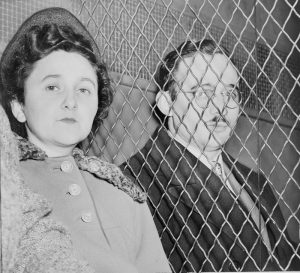
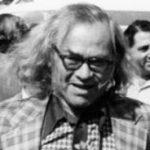 I could never begin to understand how an American citizen could be so evil as to commit espionage against the United States by selling secrets to other countries, but then again, that is not something that is so unusual these days. In the 1940’s, however, it wasn’t so common. Nevertheless, Julius Rosenberg and Ethel Rosenberg were American citizens who were convicted of spying on behalf of the Soviet Union. The Rosenbergs were accused of providing top-secret information about radar, sonar, jet propulsion engines, and valuable nuclear weapon designs to the Soviet Union at a time when the United States was the only country in the world with nuclear weapons. Imagine if we could go back to that time. The Rosenbergs were convicted of espionage in 1951, and they were executed by the federal government of the United States in 1953 in the Sing Sing correctional facility in Ossining, New York. They were the first American civilians to be executed for such charges and the first to suffer that penalty during peacetime.
I could never begin to understand how an American citizen could be so evil as to commit espionage against the United States by selling secrets to other countries, but then again, that is not something that is so unusual these days. In the 1940’s, however, it wasn’t so common. Nevertheless, Julius Rosenberg and Ethel Rosenberg were American citizens who were convicted of spying on behalf of the Soviet Union. The Rosenbergs were accused of providing top-secret information about radar, sonar, jet propulsion engines, and valuable nuclear weapon designs to the Soviet Union at a time when the United States was the only country in the world with nuclear weapons. Imagine if we could go back to that time. The Rosenbergs were convicted of espionage in 1951, and they were executed by the federal government of the United States in 1953 in the Sing Sing correctional facility in Ossining, New York. They were the first American civilians to be executed for such charges and the first to suffer that penalty during peacetime.
On March 6, 1951, the trial of Ethel and Julius Rosenberg began in New York Southern District federal court. Presiding over the espionage trial was Judge Irving R Kaufman. The couple was charged with espionage, rather than treason, because the latter could not be charged since the United States was not at war with the Soviet Union at the time of the crime’s commission. The father and son team of Emanuel and Alexander Bloch defended the Rosenbergs and their co-defendant, Morton Sobell. Roy Cohn, best known for his association with Senator Joseph McCarthy prosecuted the trio.
The Rosenbergs and Sobell, along with other co-conspirators were directly responsible for the beginning of the Cold War. Julius Rosenberg’s brother-in-law, David Greenglass was a machinist at Los Alamos, where America developed the atomic bomb. Rosenberg was a member of the American Communist Party and was fired from his government job during the Red Scare. According to Greenglass, Rosenberg asked him to pass highly confidential instructions on making atomic weapons to the Soviet Union. In compliance, Greenglass gave the information to Harry Gold, who gave it to the Russians. The Soviets exploded their first atomic bomb in September 1949, effectively starting the Cold War, based on information, including that from Greenglass, they had obtained from spies.
The confession of Greenglass was the only direct evidence of the Rosenberg’s involvement. The left-wing  community believed that the Rosenbergs were prosecuted because of their membership in the Communist Party. The Rosenbergs became the cause of leftists throughout the nation. The rest of their family, including their two sons declared the innocence of the Rosenbergs for years. The trial lasted nearly a month…ending on April 4, 1951. Sobell received a thirty year sentence. Greenglass got fifteen years for his cooperation. Reportedly, the Rosenbergs were offered a deal in which their death sentences would be commuted in return for an admission of their guilt. They refused and were executed. In 2008, the only surviving defendant, Morton Sobell, admitted that he was a Soviet spy and implicated Julius Rosenberg in industrial and military espionage.
community believed that the Rosenbergs were prosecuted because of their membership in the Communist Party. The Rosenbergs became the cause of leftists throughout the nation. The rest of their family, including their two sons declared the innocence of the Rosenbergs for years. The trial lasted nearly a month…ending on April 4, 1951. Sobell received a thirty year sentence. Greenglass got fifteen years for his cooperation. Reportedly, the Rosenbergs were offered a deal in which their death sentences would be commuted in return for an admission of their guilt. They refused and were executed. In 2008, the only surviving defendant, Morton Sobell, admitted that he was a Soviet spy and implicated Julius Rosenberg in industrial and military espionage.
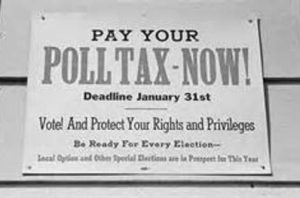 Those of us living today, might not have heard of a thing called a Poll Tax, but it was a very real thing, and with the election process just behind us, I think this might be something worth hearing. The Poll Tax was also known as a head tax or a capitation tax (meaning a tax for a head count). When I first thought about this particular tax, I thought well, maybe that kind of a tax could have ensured a fair election, but really, the opposite is true. While the head tax was considered an important source of revenue for many governments, from ancient times until the 19th century, in the United States at least; voting poll taxes (whose payment was a precondition to voting in an election) have been used to disenfranchise impoverished and minority voters (especially under Reconstruction). I find that absolutely unbelievable. In this nation in most election years, we have to practically beg people to get out and vote. Charging them money for it would all but insure a poor turnout. It would also insure that only those well enough off to be able to “throw money” at an election would be able to vote. Now that is truly appalling.
Those of us living today, might not have heard of a thing called a Poll Tax, but it was a very real thing, and with the election process just behind us, I think this might be something worth hearing. The Poll Tax was also known as a head tax or a capitation tax (meaning a tax for a head count). When I first thought about this particular tax, I thought well, maybe that kind of a tax could have ensured a fair election, but really, the opposite is true. While the head tax was considered an important source of revenue for many governments, from ancient times until the 19th century, in the United States at least; voting poll taxes (whose payment was a precondition to voting in an election) have been used to disenfranchise impoverished and minority voters (especially under Reconstruction). I find that absolutely unbelievable. In this nation in most election years, we have to practically beg people to get out and vote. Charging them money for it would all but insure a poor turnout. It would also insure that only those well enough off to be able to “throw money” at an election would be able to vote. Now that is truly appalling.
It is my understanding that originally the “poll tax” or maybe more correctly, head tax was not about an election, but more like the census. It even has Biblical roots…Mary and Joseph went to Bethlehem to be counted and pay their taxes to Caesar Augustus. This was the first of the head taxes. The tax might have been originally a way to bring in revenue. The poll taxes that followed, in most cases, were purely discriminatory. 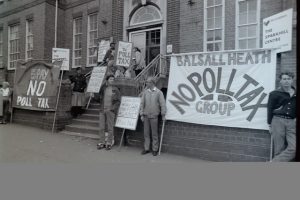 These latter poll taxes ensured that only wealthy people got the chance to cast their vote…thereby putting in candidates that those in charge wanted.
These latter poll taxes ensured that only wealthy people got the chance to cast their vote…thereby putting in candidates that those in charge wanted.
While the Poll Tax might have been a way to bring in money for governments, it seems to me that it could also be a way to make sure that the people vote for the candidate the government wants. Those who might have voted for change to improve the situation in their own neighborhoods, towns, cities, and states, were usually the poorer people, but they couldn’t vote for someone who could help, because they didn’t have the money. Many of these people were minorities. Head taxes were important sources of revenue for many governments from ancient times until the 19th century. In the United Kingdom, poll taxes were levied by the governments of John of Gaunt in the 14th century, Charles II in the 17th and Margaret Thatcher in the 20th century. By their very nature, poll taxes are considered very regressive taxes, are usually very unpopular and have been implicated in many uprisings.
On August 27, 1962, the Twenty-fourth Amendment (Amendment XXIV) of the United States Constitution was proposed. The Twenty-fourth Amendment prohibits both Congress and the states from conditioning the right to vote in federal elections on payment of a poll tax or other types of tax. The amendment was ratified by the states on January 23, 1964. When the 24th Amendment was ratified in 1964, five states still retained a poll tax. Those states were Alabama, Arkansas, Mississippi, Texas, and Virginia. These states continues the practice 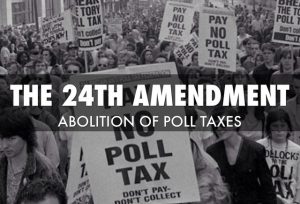 even though the amendment prohibited requiring a poll tax for voters in federal elections. Finally, in 1966 the US Supreme Court ruled 6–3 in Harper v. Virginia Board of Elections, that poll taxes for any level of elections were unconstitutional. The ruling stated that the poll tax violated the Equal Protection Clause of the Fourteenth Amendment. Further litigation related to potential discriminatory effects of voter registration requirements has generally been based on application of this clause. Those of us living today, might not have heard of a thing called a Poll Tax, but it was a very real thing, and with the election process just behind us, I think this might be something worth hearing. The Poll Tax was also known as a head tax or a capitation tax (meaning a tax for a head count).
even though the amendment prohibited requiring a poll tax for voters in federal elections. Finally, in 1966 the US Supreme Court ruled 6–3 in Harper v. Virginia Board of Elections, that poll taxes for any level of elections were unconstitutional. The ruling stated that the poll tax violated the Equal Protection Clause of the Fourteenth Amendment. Further litigation related to potential discriminatory effects of voter registration requirements has generally been based on application of this clause. Those of us living today, might not have heard of a thing called a Poll Tax, but it was a very real thing, and with the election process just behind us, I think this might be something worth hearing. The Poll Tax was also known as a head tax or a capitation tax (meaning a tax for a head count).

